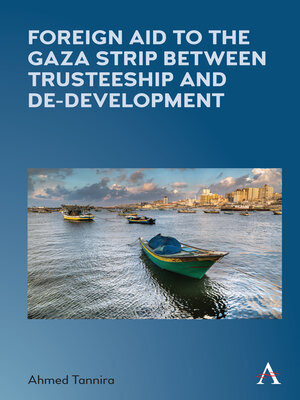Foreign Aid to the Gaza Strip between Trusteeship and De-Development
ebook ∣ Anthem Frontiers of Global Political Economy and Development
By Ahmed Tannira

Sign up to save your library
With an OverDrive account, you can save your favorite libraries for at-a-glance information about availability. Find out more about OverDrive accounts.
Find this title in Libby, the library reading app by OverDrive.



Search for a digital library with this title
Title found at these libraries:
| Library Name | Distance |
|---|---|
| Loading... |
The book examines the impact of aid to the Palestinian population in the Gaza Strip from the 1993 Oslo Agreement up to 2013. It attempts to go beyond the general notion that the Israeli occupation is the main instrument of control and de-development and rather tries to investigate these aspects and the dynamics that have surrounded foreign aid delivery in the Territory. At the socio-economic level, the book explores how donors' definition of partner for peace has exacerbated socio-economic inequalities within the Palestinian population in the Gaza Strip. The book also looks at how foreign aid has been used as an instrument for particular groups to advance politically, and through this socially and economically. Hence, the book attempts to investigate the resultant socio-economic imbalances within Palestinian society in the Gaza Strip.
|The book examines the impact of aid to the Palestinian population in the Gaza Strip from the 1993 Oslo Agreement up to 2013. It attempts to go beyond the general notion that the Israeli occupation is the main instrument of control and de-development and rather tries to investigate these aspects and the dynamics that have surrounded foreign aid delivery in the Territory. At the socio-economic level, the book explores how donors' definition of partner for peace has exacerbated socio-economic inequalities within the Palestinian population in the Gaza Strip. The book also looks at how foreign aid has been used as an instrument for particular groups to advance politically, and through this socially and economically. Hence, the book attempts to investigate the resultant socio-economic imbalances within Palestinian society in the Gaza Strip.
The book employs the concept of trusteeship. According to this concept, the book argues how aid agencies use development assistance to impose forms of control and governance over underdeveloped people. The book also investigates how trusteeship works under the general assumption that development intervention is designed to a) assist underdeveloped people overcome their socio-economic problem; b) protect developed people from the surplus people (underdeveloped) who are perceived as a threat to the developed world, thus required development intervention.
The book also explores the extension of control over the Palestinian population in the Gaza Strip by examining foreign aid delivery through the Palestinian Authority, the NGO sector, and UNRWA. It proposes that the 'partner for peace' paradigm essentially used to govern the relationship between Western doors and the Palestinian Authority demonstrates that the Palestinian Authority had to fulfil security interests that best serve the interests of Israel rather than the Palestinians.







